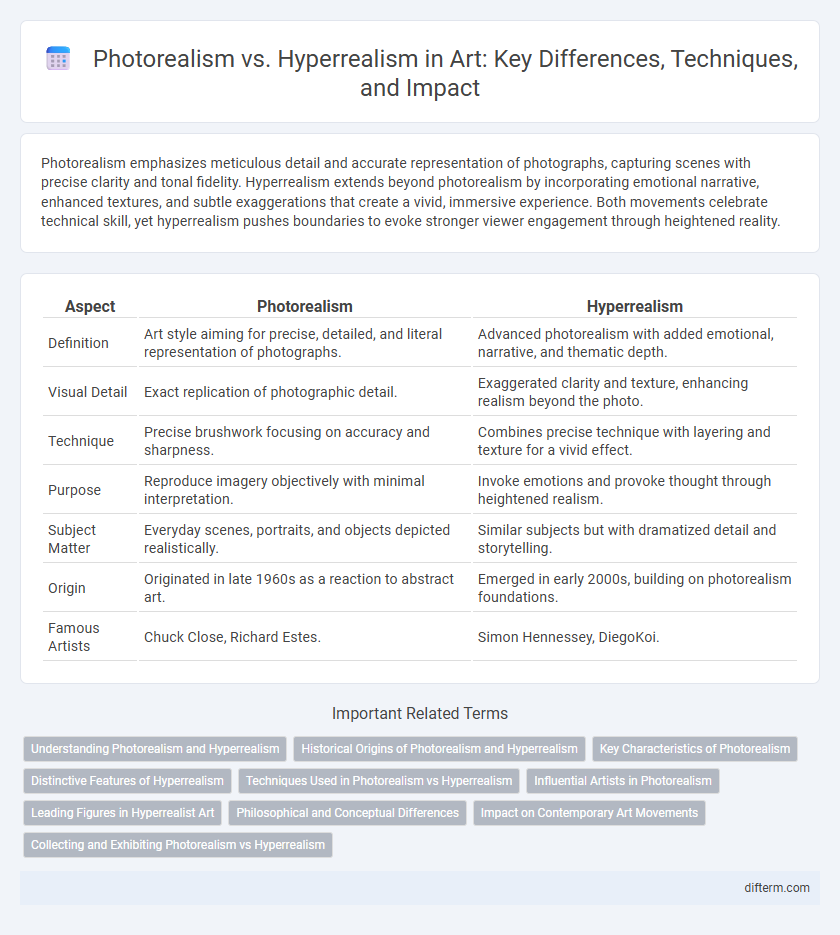Photorealism emphasizes meticulous detail and accurate representation of photographs, capturing scenes with precise clarity and tonal fidelity. Hyperrealism extends beyond photorealism by incorporating emotional narrative, enhanced textures, and subtle exaggerations that create a vivid, immersive experience. Both movements celebrate technical skill, yet hyperrealism pushes boundaries to evoke stronger viewer engagement through heightened reality.
Table of Comparison
| Aspect | Photorealism | Hyperrealism |
|---|---|---|
| Definition | Art style aiming for precise, detailed, and literal representation of photographs. | Advanced photorealism with added emotional, narrative, and thematic depth. |
| Visual Detail | Exact replication of photographic detail. | Exaggerated clarity and texture, enhancing realism beyond the photo. |
| Technique | Precise brushwork focusing on accuracy and sharpness. | Combines precise technique with layering and texture for a vivid effect. |
| Purpose | Reproduce imagery objectively with minimal interpretation. | Invoke emotions and provoke thought through heightened realism. |
| Subject Matter | Everyday scenes, portraits, and objects depicted realistically. | Similar subjects but with dramatized detail and storytelling. |
| Origin | Originated in late 1960s as a reaction to abstract art. | Emerged in early 2000s, building on photorealism foundations. |
| Famous Artists | Chuck Close, Richard Estes. | Simon Hennessey, DiegoKoi. |
Understanding Photorealism and Hyperrealism
Photorealism is an art movement where paintings are created to resemble high-resolution photographs, emphasizing precise detail and accurate light reflection. Hyperrealism builds upon photorealism by enhancing emotional narratives and often exaggerating visual elements to create an almost surreal level of detail and depth. Both styles demand technical mastery, yet hyperrealism integrates storytelling aspects that evoke stronger sensory and emotional responses.
Historical Origins of Photorealism and Hyperrealism
Photorealism originated in the late 1960s as a reaction to Abstract Expressionism, emphasizing meticulous detail and the use of photographs as primary references to create paintings indistinguishable from high-resolution images. Hyperrealism emerged in the early 2000s, building upon photorealism by incorporating narrative elements, emotional depth, and enhanced textures that go beyond photographic clarity. Both movements trace their roots to advances in photographic technology and cultural shifts toward realism, yet hyperrealism pushes the boundaries with increased illusionistic effects and conceptual complexity.
Key Characteristics of Photorealism
Photorealism emphasizes meticulous attention to detail, replicating photographs with precise accuracy to create lifelike images that often highlight everyday scenes. Artists utilize smooth surface techniques, minimizing visible brushstrokes, to enhance the illusion of reality and provide a sense of immediacy. The focus lies on objective representation rather than emotional interpretation, distinguishing photorealism through its technical precision and emphasis on capturing light and texture authentically.
Distinctive Features of Hyperrealism
Hyperrealism distinguishes itself from photorealism through its intense focus on emotional expression and narrative elements, often incorporating minute details that evoke a lifelike presence beyond mere photographic accuracy. This art style employs advanced techniques like layering and airbrushing to enhance textures and light reflections, creating a more immersive and tactile experience. Hyperrealist artists frequently manipulate scale and atmosphere to deepen viewer engagement, making their work resonate on both visual and emotional levels.
Techniques Used in Photorealism vs Hyperrealism
Photorealism employs meticulous airbrushing, precise brushwork, and photographic references to replicate images with exact detail and smooth surfaces. Hyperrealism extends these techniques by incorporating intricate textures, emotional expression, and three-dimensional depth, often enhancing reality to evoke stronger sensory engagement. Both movements utilize advanced layering and blending methods but diverge in intent, with photorealism emphasizing accuracy and hyperrealism focusing on heightened perception.
Influential Artists in Photorealism
Chuck Close and Ralph Goings pioneered photorealism by meticulously replicating photographic details on canvas, emphasizing technical precision and surface texture. Audrey Flack integrated symbolism and vibrant colors, transforming photo-referenced images into emotive narratives that bridge realism and personal meaning. Richard Estes elevated urban scenes through reflective surfaces and intricate details, capturing everyday life with a clarity that challenges the boundary between photography and painting.
Leading Figures in Hyperrealist Art
Chuck Close and Ron Mueck are leading figures in hyperrealist art known for their meticulous attention to detail and lifelike representations. Close's large-scale portraits emphasize intricate textures and facial features, while Mueck's sculptural works capture human expressions with striking realism. Their contributions have significantly advanced hyperrealism, setting it apart from photorealism through heightened emotional intensity and three-dimensionality.
Philosophical and Conceptual Differences
Photorealism emphasizes meticulous replication of photographic details to challenge perceptions of reality and representation, highlighting the medium's limitations and the relationship between art and photography. Hyperrealism extends beyond mere replication to evoke emotional narratives and social commentary, creating an intensified reality that often transcends the original photograph. Philosophically, photorealism questions the authenticity of images while hyperrealism engages deeper conceptual explorations of reality, illusion, and human experience.
Impact on Contemporary Art Movements
Photorealism and hyperrealism have significantly influenced contemporary art by challenging traditional boundaries between photography and painting, encouraging artists to explore meticulous detail and realism. Photorealism's emphasis on replicating photographic images fosters a dialogue about perception and representation, while hyperrealism intensifies emotional engagement through exaggerated clarity and narrative elements. These movements collectively inspire new explorations in visual storytelling, pushing contemporary artists to blend technical skill with conceptual depth.
Collecting and Exhibiting Photorealism vs Hyperrealism
Collecting photorealism often appeals to enthusiasts who value precise, camera-like detail that emphasizes everyday scenes, while hyperrealism attracts collectors drawn to exaggerated textures and emotional depth that transcend mere replication. Exhibiting photorealism typically involves showcasing technical mastery and faithful representation, whereas hyperrealism exhibitions prioritize immersive experiences that evoke intense sensory and psychological responses. Galleries and museums increasingly curate both styles to highlight evolving perceptions of reality in contemporary art.
photorealism vs hyperrealism Infographic

 difterm.com
difterm.com